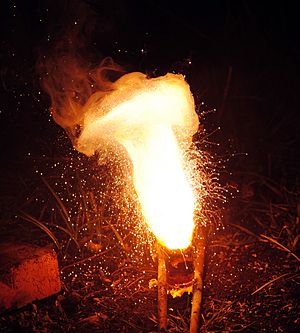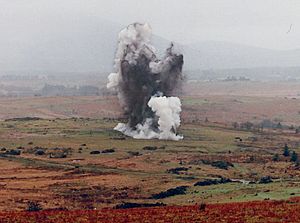Exothermic process facts for kids
An exothermic process is a scientific term for something that releases energy into its surroundings. This energy usually comes out as heat, making things warmer. But it can also be released as light (like a spark or a flame), electricity (like in a battery), or even sound (like an explosion). The word exothermic was first used by a French chemist named Marcellin Berthelot.
The opposite of an exothermic process is an endothermic process. An endothermic process absorbs energy, usually as heat, from its surroundings. Scientists often use these terms to describe chemical reactions where the energy stored in chemical bonds changes into thermal energy (heat).
Contents
Exothermic and Endothermic Reactions
Exothermic and endothermic describe two main types of chemical reactions or systems we find in nature.
What is an Exothermic Reaction?
After an exothermic reaction, more energy has been released into the surroundings than was needed to start the reaction.
A good example is burning a candle. When the candle wax burns, it releases a lot of heat and light. This released energy is much more than the small amount of energy needed to light the candle and keep the flame going. The burning wax turns into hot carbon dioxide and water vapor, making the area around the candle warmer.
What is an Endothermic Reaction?
In an endothermic reaction, energy is taken from the surroundings as the reaction happens. This usually makes the surroundings feel cooler.
A common example is a first aid cold pack. When you activate it, two chemicals mix or one dissolves in another. This process needs energy, which it takes from the surroundings. This makes the pack and the area around it feel cold.
Photosynthesis is another great example of an endothermic process. Plants use sunlight to turn carbon dioxide and water into sugar and oxygen. They absorb radiant energy from the sun to make this happen. The energy stored in the sugar can then be released later by burning it, which is an exothermic process.
How Energy is Released
When an exothermic process happens, a system releases energy, usually as heat, to its surroundings.
In a system that doesn't exchange heat with its surroundings (called an adiabatic system), an exothermic process will cause the temperature of the system to go up.
In exothermic chemical reactions, the released heat can be in the form of light or the movement of molecules. When electrons move from one energy level to another, light can be released. This light carries energy that comes from the chemical reaction, specifically from the bond energy. This light can then be absorbed by other molecules, causing them to move and vibrate, which we feel as heat. For an exothermic reaction to start, it needs some initial energy (called activation energy). But the energy it releases afterward is much greater than this starting energy, so there's a net release of energy.
Everyday Examples

Here are some common examples of exothermic processes:
- Burning fuels like wood, coal, or oil.
- The thermite reaction, which creates intense heat and molten metal.
- When alkali metals (like sodium) react with water.
- When rain forms from water vapor (this is called condensation).
- Mixing water with strong acids or strong bases.
- The reaction between acids and bases.
- When cement and concrete harden.
- Some reactions that create plastics, like when epoxy resin sets.
- Most metals reacting with halogens (like chlorine) or oxygen.
- Nuclear fusion (like in the sun or hydrogen bombs).
- Nuclear fission (when heavy elements split apart).
- The reaction between zinc and hydrochloric acid.
- Cellular respiration (how our bodies break down sugar to get energy).
Why Exothermic Reactions are Important
Chemical exothermic reactions tend to happen more easily or "spontaneously" than endothermic reactions. This is because they release energy, which often makes the system more stable.
In a chemical reaction that releases heat, you might see the heat listed as one of the "products" of the reaction.
See Also
 In Spanish: Proceso exotérmico para niños
In Spanish: Proceso exotérmico para niños
- Calorimetry
- Chemical thermodynamics
- Differential scanning calorimetry
- Endergonic
- Endergonic reaction
- Exergonic
- Exergonic reaction
- Endothermic reaction


